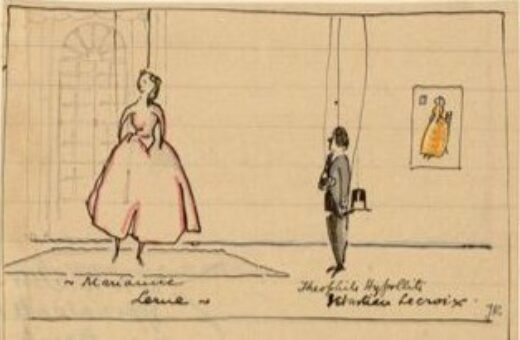
Printed
Page count
Author(s)
Noa
Une conversation marionnettique en style "snap-shot"
The Drama for Fools is a long theatrical cycle containing multiple interludes, including Noa (Nan-an). This cycle kept Craig very busy between 1916 and 1918. It was supposed to hold 365 short plays and be performed like a traveling show: each night, from April 1st to March 31st, a new play was to be performed in a new location. Craig, who signed his plays under the nickname Tom Fool, stopped writing before the cycle was finished and gave up on performing the play himself. Nonetheless, he managed to keep his drafts in three cardboard boxes, as a collection of typewritten notebooks containing a myriad of illustrations and whose covers were calligraphed in different colors. He cared immensely for these notebooks: he improved, corrected, and added material to them until the 1950s. Nowadays, this collection belongs to the International Puppet Institute (Institut International de la Marionnette), based in Charleville-Mézières.
The play is introduced by Craig as “not the shortest drama in the world but the second shortest, (the shortest being Yes, written by the same author). The interlude is dedicated to actor and singer Yvette Guilbert and to poet Stéphane Mallarmé. The comical dimension comes from the burlesque entanglement of the English and French languages within the same sentence. This was a familiar situation for Craig, who, after leaving Great Britain in 1903, was spending a lot of time in international circles without being fluent in any foreign language.
The allusion to Goethe’s Mephistopheles is obvious: the character displays himself as “der Geist der stets verneint!” (The Spirit that always denies!, Faust I, v. 1338).
A woman turns down everything
Théophile Hippolyte Sébastien Lacroix visits Marianne Larue and suggests different outings that she declines without exception, with a simple “noa” (nan-an). After Théodore’s departure, Marianne keeps answering this to all outside noises, even when the curtain goes down and the theater lights go off. Marianne’s shape can still be seen through the partly transparent curtain, while it grows excessively. The play ends with a young man’s ironic and “coarse” whistle.
Publications and translations
Edward Gordon Craig, The Drama for Fools / Le Théâtre des fous. Montpellier: L'Entretemps, 2012.
Edward Gordon Craig, The Drama for Fools / Le Théâtre des fous. Montpellier: L'Entretemps, 2012.
(French)
